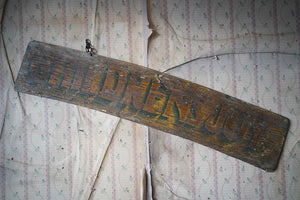Origin: English
Period: Late Victorian
Provenance: Unknown
Date: c.1890-1910
Length: 3.5”
Width: 1.25”
The single steel key with turned barrel for Napsbury Asylum, stamped "WORKMAN MW 3027” surviving from the zeniths of the Victorian period and once being part of a bunch of keys sourced from this asylum.
The key remains in original condition with no damages.
The construction of asylums was widespread in Britain following The Lunacy Act of 1845, which resulted primarily from the work of John Connolly and Lord Shaftsbury. This act professionalised the asylum, and ensured that each institution was mediated by the local authority. It marked a paradigmatic shift, wherein ‘lunatics’ began to be considered as patients instead of prisoners.
Napsbury Hospital was a mental health facility near London Colney in Hertfordshire. It had two sister institutions, Harperbury Hospital and Shenley Hospital, within a few miles of its location.
History. The hospital was designed by Rowland Plumbe in the country estate style and was initially known as the Middlesex County Asylum.
The hospital was designed for 1,205 residents, and the grounds were designed by William Goldring. Following the construction of the numerous buildings and extensive grounds, Napsbury opened on 3 June 1905. According to the Middlesex County Record, the initial cost, including land and equipment, was £545,000, or £473 per bed. In 1908 Plumbe designed an extension to accommodate a further 600 patients.
During the First World War, Napsbury was used for and known as the County of Middlesex War Hospital, which treated wounded soldiers. Following the war, the hospital was returned to its original purpose. Although Napsbury suffered some bomb damage in the Blitz, it was in continuous use as a hospital until its official closure in 1998. However, until at least 2002 one building was still in use for psychiatric patients.
Due to its largely untouched parkland, Napsbury was listed by English Heritage as a Grade II Historic Park and Garden in 2001.The site has been redeveloped for residential use as Napsbury Park. Louis Wain and Ivor Gurney were among its famous residents, as well as David Walliams' grandfather, as seen in the BBC TV show "Who Do You Think You Are?". Several workhouses, contained wards exclusively used for lunatics and in some places a separate building (belonging to and administered by the local Poor Law authority) was used exclusively for the lunatics, or as a general hospital with lunatic wards.
The Asylum Rule Book stated the following:
“There be at least one attendant for every ward and that there be not less than one attendant for every 25 patients who are tranquil or convalescent and not less than one attendant for every 12 patients who are dirty, violent, refractory or dangerous to themselves or others. No ward shall be left at any time without an attendant being there and that the attendant be so distributed that in case of need they may readily assist each other.”
Probably a unique key and an object with a huge amount of gravitas.
Period: Late Victorian
Provenance: Unknown
Date: c.1890-1910
Length: 3.5”
Width: 1.25”
The single steel key with turned barrel for Napsbury Asylum, stamped "WORKMAN MW 3027” surviving from the zeniths of the Victorian period and once being part of a bunch of keys sourced from this asylum.
The key remains in original condition with no damages.
The construction of asylums was widespread in Britain following The Lunacy Act of 1845, which resulted primarily from the work of John Connolly and Lord Shaftsbury. This act professionalised the asylum, and ensured that each institution was mediated by the local authority. It marked a paradigmatic shift, wherein ‘lunatics’ began to be considered as patients instead of prisoners.
Napsbury Hospital was a mental health facility near London Colney in Hertfordshire. It had two sister institutions, Harperbury Hospital and Shenley Hospital, within a few miles of its location.
History. The hospital was designed by Rowland Plumbe in the country estate style and was initially known as the Middlesex County Asylum.
The hospital was designed for 1,205 residents, and the grounds were designed by William Goldring. Following the construction of the numerous buildings and extensive grounds, Napsbury opened on 3 June 1905. According to the Middlesex County Record, the initial cost, including land and equipment, was £545,000, or £473 per bed. In 1908 Plumbe designed an extension to accommodate a further 600 patients.
During the First World War, Napsbury was used for and known as the County of Middlesex War Hospital, which treated wounded soldiers. Following the war, the hospital was returned to its original purpose. Although Napsbury suffered some bomb damage in the Blitz, it was in continuous use as a hospital until its official closure in 1998. However, until at least 2002 one building was still in use for psychiatric patients.
Due to its largely untouched parkland, Napsbury was listed by English Heritage as a Grade II Historic Park and Garden in 2001.The site has been redeveloped for residential use as Napsbury Park. Louis Wain and Ivor Gurney were among its famous residents, as well as David Walliams' grandfather, as seen in the BBC TV show "Who Do You Think You Are?". Several workhouses, contained wards exclusively used for lunatics and in some places a separate building (belonging to and administered by the local Poor Law authority) was used exclusively for the lunatics, or as a general hospital with lunatic wards.
The Asylum Rule Book stated the following:
“There be at least one attendant for every ward and that there be not less than one attendant for every 25 patients who are tranquil or convalescent and not less than one attendant for every 12 patients who are dirty, violent, refractory or dangerous to themselves or others. No ward shall be left at any time without an attendant being there and that the attendant be so distributed that in case of need they may readily assist each other.”
Probably a unique key and an object with a huge amount of gravitas.







